Description :
The premiere showing of this opera occured on February 15th (2003) in the Performing Arts Hall of Tokyo Gakugei University.
(Over 200 people came to the premiere, which was well-received. Plans are now in progress for future performances in Japan and abroad)
Click here to view the sequence of this performance.
Click here for maps to the hall.
Tokyo Gakugei University Arts Hall

"Correspondence" is a new opera.
It started from letters that Eric Van Hove wrote from Japan (since his arrival in April 2001) and sent to friends and relatives in Europe.
These letters, which Eric felt compelled to write, described various aspects of contemporary Japan, including subjects as various as Tokyo "architecture", "sleepiness that surprises the natives", Japanese women's bosoms, the Nippon language facing Western art, and the risks of Asking.
Recognizing the significance of Eric`s work, composer David Hebert produced orchestral music to accompany these letters, some of which became songs, while others are read over a musical backdrop.
This opera seeks to join the silence of writings and the sound of music together, and its theme is illustrated by the following points:
- Does the sound of a foreign language not become musical before its words overcome their misunderstood meaning?
- Is music not a form of metalanguage that overcomes language itself: If it is not translated, it must be universal.
- Does translation not find it's echo in the artist's work : to translate its inspiration.
- Before an audience of diverse languages and cultures, how may an artist use writings without negotiating the divisions that -- unlike music -- they will generate?
- Is Chinese and Japanese script not at the same time both drawings and words: he who cannot read them, may still contemplate them.
- ...
It is upon the basis of such questions that Correspondence, utilizing different languages and musical instruments, as well as projections and writing installations, finds its expression.
And it is through exploration of the connections between such themes that its title was discovered.
Images of the Premiere Performance in Tokyo:
Sneak Preview:
On Wednesday, January 8, selected pieces from Correspondence were performed at the Higashi Kurume School for Disabled Children.
It was an unusual opportunity to cross borders of many kinds. We hope for further opportunities to share this evolving project with diverse audiences in the future.
Artist Profiles (directors/producers):
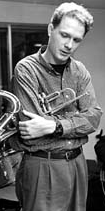 David Gabriel Hebert, composer, conductor David Gabriel Hebert, composer, conductor
Born in Seattle, a PhD Candidate in music at the University of Washington.
David`s works have been broadcast on radio and television. He has taught widely and published research on music in Asia.
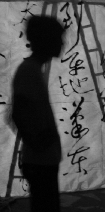 Eric Van Hove, poet, nomad, sculptor Eric Van Hove, poet, nomad, sculptor
A Belgian born in Africa, Eric is a graduate of the Brussels College of Contemporary Art(St-Luc).
Monbusho Research Associate in Art (Calligraphy), his work has been displayed in several Tokyo/European galleries.
Words from his hand echo the reluctance of Melville's Barthelby : "I would prefer not to".
Featured Perfomers:
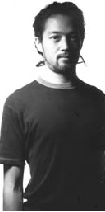 Kenji Williams, violinist, DJ Kenji Williams, violinist, DJ
Classically trained in violin since the age of 7, Kenji has a broad experience in classical performance, electronic composition, and soundtrack work. In addition to performing violin and touring around the world with tribal trance group Medicine Drum, Kenjifs solo trance-tech house, and downtempo dub project gABA Structureh has released several EPfs, including tracks on John Digweedfs gBedrockh compilation, and the latest release on Plastic City Americas.
Several projects with the gEclipseh (Flying Rhino) project have showcased ABAfs downtempo work, already releasing 3 tracks by Kenji, with a fourth one to be released later in 2002. Kenji is currently the producer for a Tower Records full length album with singer Veronika Sandor, for release in November 2002 as well as doing A&R for the Vision Quest label in Japan.
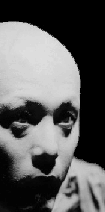 ßRÓç - Kinya "ZULU" Tsuruyama, Butoh dancer ßRÓç - Kinya "ZULU" Tsuruyama, Butoh dancer
YAN-SHU was formed by Kinya "ZULU" Tsuruyama while he was in Dai-Rakuda-Kan, one of Japan's most important butoh groups. While abroad in 1995, he performed in Berlin with the Theatre Danse Grotesque. While in Europe, in addition to performing, Zulu taught and directed butoh workshops. He performed in Coucourse by Maurice Bejart in Germany's STATSOPERA and he also appeared in Peter Greenaway's film "The Pillow Book" as a messenger.
YAN-SHU performed at Sphere Mex (Tokyo) and at the San Francisco Butoh Festival ('98), toured in London and Bilbao ('99), Festival delle Rocche in Italy ('99), Tokyo Dance Selection '99, Japan Society, N.Y. ('00), workshop and performance in Cuba and Mexico City ('00), Lilian Baylis Theatre, London ('01) and the latest work is "YAN-SHU's workshop project and Performance" in Mexico City.('02).
Musicians:
Soprano soloist (voice): Kana YAMAZAKI
Tenor soloist (voice): Sohei SHIBUYA
Assistant Director/Cello: Matthew ROBEY
Flute: Rie IWATSUKI
Oboe: Yasuyuki WATANABE
Clarinet: Mariko KIUCHI
Euphonium: Yuya MURAMATSU
Trombone: Makoto KANEKAWA
Tuba: Yasutaka TONOIKE
Piano: Mihoko NAGAI
Percussion: Harumi YASUNAGA
Japanese translation:
TANAKO, Seiko: translator, interpreter
Video and photo documents:
Cesar DIAZ (1973-?), Photographer, Videographer, Semiologist
Born in Bogota, Colombia. Studied Audiovisual Communication at the Pontificia Universidad Javeriana. For four years, taught Semiotics of Still Image at the same university while simultaneously involved in independent and institutional ultra-low-budget video, film and radio projects on a free lance basis (i.e., for free most of the time), making anything from coffee for the staff and babysitting to still photography, camera work, lighting and editing.
Currently in Japan as a Monbusho Scholarship Student, studies Japanese Language at Nihon Daigaku in order to enter the Master Course in Film Production in 2004.
Shoots many times before getting an acceptable picture and hates to write in third person.
Visual projections and light coordinator:
Masato OHNO
Performance Plan :
I. letter to Olivier Foulon :
"Latin languages, languages of merchants"
(Eric Van Hove read in French)
II. letter to Isabelle Mairiaux :
"a region at the foot of Mt. Fuji, beside a lake"
(Sung in English by SHIBUYA Sohei - Tenor)
III. letter to Michel Assenmaker :
"twisted, swollen: it is a woman's foot"
(Read in English over Hebert/Williams duet, with dance by Kinya Tsuruyama)
IV. letter to Dominique Thirion :
"they do more than rest"
(Sung in English by YAMAZAKI Kana - Soprano)
V. letter to Pierre Culot :
"there are a lot of earthquakes here, as you know"
(Sung in English by YAMAZAKI Kana - Soprano)
VI. letter to Michel Assenmaker :
"being suddenly so far from truth"
(Read in English over music)
VII. letter to Olivier Foulon :
"the Temple of Ogamiyama, at the edge of an endless path of moist steps"
(Sung in English by SHIBUYA Sohei - Tenor)
VIII. letter to Michel Assenmaker :
"into its island, onto its natives"
(Read in Japanese by Ochi CHIHIRO with performance by Kenji Williams)
IX. letter to Olivier Foulon :
" but "
(Eric Van Hove read in French over orchestral/electronic music)
X. letter to Pierre Culot :
"and violate, is it not to whither the possibility to again offend beauty?"
(Sung in English by YAMAZAKI Kana - Soprano, and SHIBUYA Sohei - Tenor)
How to get there :
The hall is located inside the Tokyo Gakugei University campus, which is located in the western suburbs of Tokyo.
From JR Shinjuku station, please take the JR Chuo line (rapid service) and get off at the JR Musashi-Koganei Station (recommended).
From the JR Musashi-Koganei Stn. :
By Bus : Take Bus #41 to the Seven Eleven on the right (gakugeidai seimon mae)... walk down tree lined street into Campus, and turn left at the gate!
Maps :
From the JR Shinjuku station to the JR Musashi-Koganei Stn. :
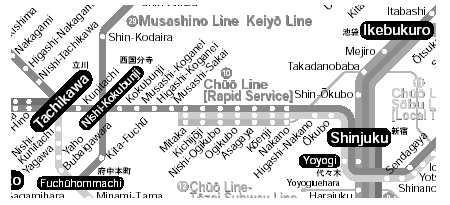
From the JR Musashi-Koganei Stn. to the Tokyo Gakugei University Hall :

|



